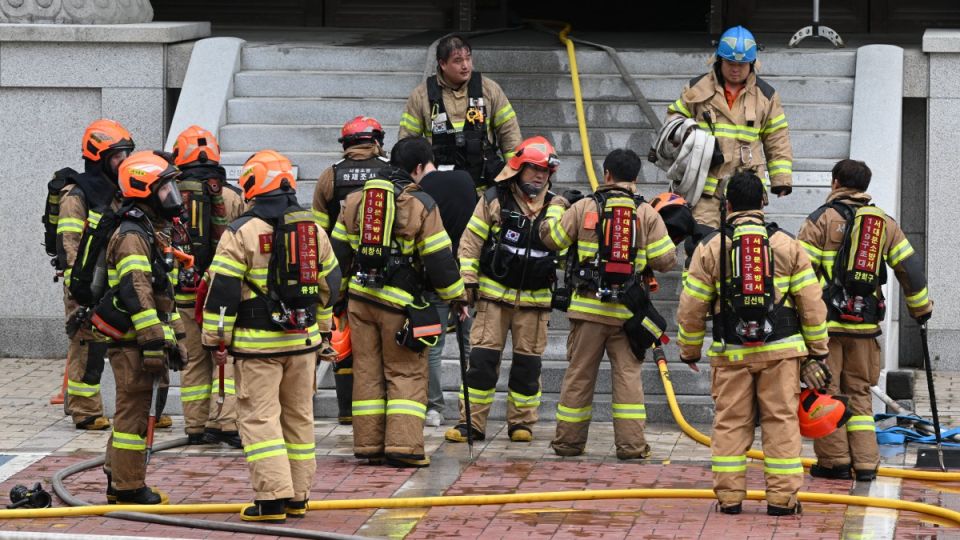September 29, 2025
SEOUL – The Ministry of Interior and Safety said Sunday critical infrastructure had been repaired at a government-run data center where a fire forced hundreds of electronic government services offline, but weeks of work would likely be needed to fully restore the systems.
The National Information Resources Service, where the fire broke out, plays a critical role in providing government services, such as identity verification and issuing public records. The shutdown blocked access to government-run websites as well as public services such as Korea Post, Government24 and the mobile ID application.
President Lee Jae Myung apologized in a meeting with Cabinet for the inconvenience caused to the public. During the meeting Sunday afternoon at the Central Disaster and Safety Countermeasures Headquarters, he was briefed on the incident and recovery efforts. Officials of South Korean cloud services firms also attended.
A total of 647 government information systems are housed at the NIRS in Daejeon, of which 96 have been confirmed as directly damaged by the fire.
As of Sunday, the central disaster headquarters said repairs to infrastructure required to restart the systems had been completed, and work had started on the more time-consuming task of restoring the networks.
According to the Interior Ministry, restoring all 96 damaged systems will take about two weeks, though the exact time needed was still unclear. In the meantime, the government will focus on restoring the unaffected systems to minimize disruption to the public.
Fire and police authorities, as well as the National Forensic Service, officially began on-site inspections on Sunday morning, a day after the blaze was completely extinguished.
“Government agencies are working to restore administrative services as swiftly as possible, and we will continue to transparently disclose the recovery progress and the outcome of the investigation,” said Vice Interior Minister Kim Gwan-yong during an earlier meeting at the disaster headquarters on Sunday morning.
Presidential spokesperson Kang Yu-jung told the press on Sunday that President Lee vowed to “minimize public disruption” caused by the fire in Daejeon, especially with South Koreans due to celebrate a weeklong Chuseok holiday in early October.
“Through rapid system restoration and reactivation, we will minimize inconvenience to the public,” Lee was quoted as saying by Kang at an emergency response meeting with his aides Sunday morning.
It was unclear as of press time when exactly the affected systems would be brought back online.
As of 7 a.m. Sunday, more than 50 percent of affected network devices had been reactivated, while 763 of 767 critical security devices were back in operation.
Additionally, a key cooling and dehumidification unit that is vital to stable server operations was restored at 5:30 a.m., and all 384 lithium-ion batteries destroyed in the blaze were removed from the site by 9:36 p.m. on Saturday, according to the government.
In a situation report issued by the Interior Ministry on Sunday, the ministry stated that it aimed to check all 551 of the affected systems on Sunday — having shut them down preemptively to prevent heat damage. It said it planned to bring them back online in phases once communication and security infrastructure is stable.
At 8:20 p.m. on Friday, fire authorities received a report of a lithium-ion battery fire at a server room in the NIRS. An uninterruptible power supply (UPS) battery that had been disconnected for relocation to the basement was later identified as the source of the fire. UPS batteries are designed to maintain a stable power supply to IT systems in the event of an outage.
According to the Interior Ministry, the UPS batteries had been installed in August 2014, and had been in place a year past their recommended 10-year lifespan. While the ministry stressed that the batteries had undergone regular inspections without issues, some industry experts were quoted in local media reports as saying that the workers may have removed wiring before cutting power, potentially triggering a short circuit.
The police have set up a 20-member task force to determine what caused the battery to ignite.
The joint probe will assess whether outdated components, mishandling during relocation or inadequate oversight by contractors in charge of managing the server room contributed to the incident.
lee.jungjoo@heraldcorp.com


